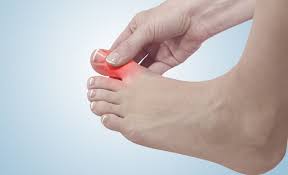Big Toe Pain – Is It Hallux Rigidus?

Written by Michelle Champlin BSc Pod., M.Ch.S., S.R., Ch., (UK)
Maybe your Podiatrist or Orthopaedic Surgeon has told you that you have ‘hallux rigidus’? But what exactly does this mean and do you need to do anything to treat it? Chief Podiatrist Michelle Champlin lends us some insight into this toe condition.
What is ‘hallux rigidus’?
Hallux rigidus is the medical name for having a ‘stiff big toe’. Your hallux is your big toe; ‘rigidus’ means ‘stiff.’
Mrs Champlin, Chief Podiatrist at Dubai Podiatry Centre explains: “Every one of us will get some amount of osteoarthritic changes to our bones as we age. This is completely normal and to be expected as we go through adulthood. Hallux rigidus occurs when these arthritic changes occur in the joint of your big toe – what we call the ‘metatarso-phalangeal joint’, to the extent that it can cause symptoms such as pain or stiffness in the joint”. We’ll just call it the MTP joint from now on!
Symptoms of hallux rigidus
• Stiffness and pain in your MTP joint (worse in cold, damp weather and when walking or running)
• Swelling and inflammation around the joint
• Difficulty flexing the joint when you’re walking, squatting etc.
What causes hallux rigidus?
Osteo-arthritic changes happen to all of us as we age. This is the kind of arthritis that is due to normal wear and tear. However, these changes can be worsened in the MTP joint for some of us for the following reasons:
• A foot / ankle biomechanical issue affecting how your foot moves and functions. (Commonly seen in the many of us who over-pronate and/or have lowered medial long arches)
• Inherited from your mum or dad (genetic)
• Increased ongoing stress on the MTP joint from a job or activity that requires a lot of squatting type movement
• An injury to the big toe area – such as stubbing the toe
• An underlying condition such as gout or rheumatoid arthritis.
What happens if I don’t treat it?
Hallux rigidus can worsen over time, causing increasing pain in the MTP joint, even at rest. It can also affect how you walk, causing you to limp. This in turn places more strain on other joints, causing knee, hip or lower backache. You may also develop bone spurs causing irritation to the skin of the area in tight footwear, leading you to buy broader footwear to accommodate.
What can be done to help hallux rigidus?
Seeking advice from a Podiatrist early on is advisable – if you’re in the UAE or travelling through, contact us.
Mrs Champlin advises that “In mild to moderate cases, the symptoms can be alleviated with custom corrective orthotic therapy, worn in your shoes to correct how your foot functions (commonly over-pronation or collapsed long arches). This corrects the underlying cause of the hallux rigidus, and takes weight away from the MTP joint, rather than just superficially treating the pain with steroid injections or anti-inflammatory medication, which will not fix the issue in the long run.”
In more severe cases, surgery by a specialist Orthopaedic Surgeon with expertise in foot surgery may be advised. After surgery (there are different procedures which the surgeon will discuss after consulting with you), the Orthopaedic Surgeon will refer you back to your Podiatrist for a post-surgical custom orthotic to maintain his/her good work in the operating theatre and stop the foot posture reverting, supporting your correct foot posture and alleviating pressure from the MTP joint.
If you are experiencing any pain at all in your big toe joint, you should always seek advice from a Podiatrist without delay. Early intervention is best, and there is always a way forward to reduce or eliminate the pain.
Contact the foot experts at Dubai Podiatry Centre on 04 3435390 for friendly informative diagnosis, explanation and treatment options.







